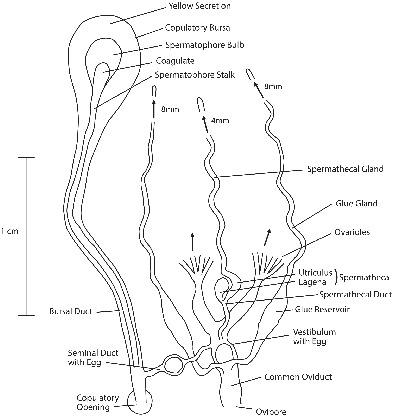当前位置:
X-MOL 学术
›
Physiol. Entomol.
›
论文详情
Our official English website, www.x-mol.net, welcomes your
feedback! (Note: you will need to create a separate account there.)
Transfer, subsequent movement, and fate of sperm in the tobacco hornworm moth, Manduca sexta
Physiological Entomology ( IF 1.6 ) Pub Date : 2021-05-07 , DOI: 10.1111/phen.12361 Nancy L. Hague 1 , Janis L. Dickinson 1, 2 , Julian G. Shepherd 1
Physiological Entomology ( IF 1.6 ) Pub Date : 2021-05-07 , DOI: 10.1111/phen.12361 Nancy L. Hague 1 , Janis L. Dickinson 1, 2 , Julian G. Shepherd 1
Affiliation

|
During mating in the Lepidoptera (moths and butterflies), sperm are passed to the female via a copulation in which the male transfers a large and often complex spermatophore over the major part of an hour or more. Subsequently, over the course of an hour or often considerably more, the sperm exit the spermatophore and travel over a relatively complex route to the spermatheca, where the sperm are stored and then used as the eggs are laid. The process of spermatophore formation and migration of sperm in the female has been described in many Lepidoptera, but the mechanics involved have received less attention. Understanding these is important in discerning the relative roles of males and females in determining the outcome of matings. We describe how the spermatophore is formed, how the sperm migrate in the female, and the fate of the sperm in the spermatheca of the tobacco hornworm moth, Manduca sexta. We found that sperm movement from the spermatophore relied upon motility of the sperm, but further movement of the sperm to the spermatheca was dependent on female muscular action. After arriving in the spermatheca, the anucleate parasperm (apyrene sperm) separated into the lateral pouch of the spermatheca (lagena) and disappeared over 7 days, whereas the eusperm (eupyrene sperm) persisted in the central lumen of the spermatheca (utriculus). The relative persistence of these two sperm types could shed some light on what determines the proclivity of females to remate. Elucidation of these physiological mechanisms contributes to an understanding of the mechanisms of female choice and male competition in Lepidoptera.
中文翻译:

烟草天蛾 Manduca sexta 中精子的转移、后续运动和命运
在鳞翅目(飞蛾和蝴蝶)的交配过程中,精子通过交配传递给雌性,其中雄性在一个小时或更长时间的大部分时间里转移一个大且通常复杂的精囊。随后,在一个小时或更长时间的过程中,精子离开精囊并通过相对复杂的路线到达受精囊,在那里储存精子,然后在产卵时使用。雌性精子细胞的形成和精子迁移的过程在许多鳞翅目中都有描述,但所涉及的机制很少受到关注。了解这些对于辨别雄性和雌性在确定交配结果中的相对作用非常重要。我们描述了精子细胞是如何形成的,精子是如何在雌性体内迁移的,曼杜卡六重奏。我们发现精子从精囊中的运动依赖于精子的运动,但精子向受精囊的进一步运动依赖于女性的肌肉活动。到达受精囊后,无核的副精子(无核精子)分离到受精囊(lagena)的侧囊中并消失了7天,而eupyrene精子(eupyrene精子)则持续存在于受精囊(utriculus)的中央管腔中。这两种精子类型的相对持久性可以揭示是什么决定了雌性再交配的倾向。阐明这些生理机制有助于理解鳞翅目雌性选择和雄性竞争的机制。
更新日期:2021-05-07
中文翻译:

烟草天蛾 Manduca sexta 中精子的转移、后续运动和命运
在鳞翅目(飞蛾和蝴蝶)的交配过程中,精子通过交配传递给雌性,其中雄性在一个小时或更长时间的大部分时间里转移一个大且通常复杂的精囊。随后,在一个小时或更长时间的过程中,精子离开精囊并通过相对复杂的路线到达受精囊,在那里储存精子,然后在产卵时使用。雌性精子细胞的形成和精子迁移的过程在许多鳞翅目中都有描述,但所涉及的机制很少受到关注。了解这些对于辨别雄性和雌性在确定交配结果中的相对作用非常重要。我们描述了精子细胞是如何形成的,精子是如何在雌性体内迁移的,曼杜卡六重奏。我们发现精子从精囊中的运动依赖于精子的运动,但精子向受精囊的进一步运动依赖于女性的肌肉活动。到达受精囊后,无核的副精子(无核精子)分离到受精囊(lagena)的侧囊中并消失了7天,而eupyrene精子(eupyrene精子)则持续存在于受精囊(utriculus)的中央管腔中。这两种精子类型的相对持久性可以揭示是什么决定了雌性再交配的倾向。阐明这些生理机制有助于理解鳞翅目雌性选择和雄性竞争的机制。











































 京公网安备 11010802027423号
京公网安备 11010802027423号